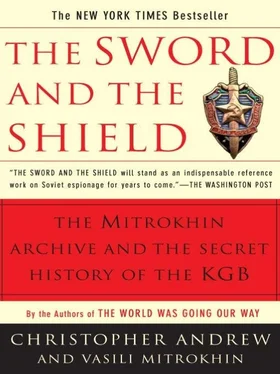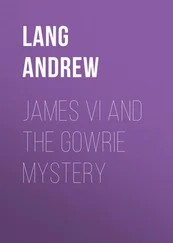ZVENO set the pattern for most Department V peacetime special actions: immensely laborious and detailed preparations, followed by a reluctant decision not to go ahead because of the political risks involved—in particular, the possibility that, despite all the precautions taken, the hand of the KGB might somehow be discovered. The operation was postponed several times, kept under review for a number of years and finally abandoned. 16
Many, perhaps most, of the proposed special actions in Europe were intended to cause dissension within NATO. A characteristic example (reproduced at the end of this chapter) was the proposal by the Athens residency in April 1969 for a bomb attack on the Turkish consulate-general in Thessaloniki, which would be blamed on a Greek extremist. Though complimenting the Athens residency on its initiative, the Centre once again dared not take the risk of giving the go-ahead. Instead, on May 12, 1969, it sent a temporizing reply:
We approve the work carried out by the residency to collect material with the aim of preparing a Lily [sabotage operation] against the YAYTSO [Turkish consulate-general] target. We have put this target on file and if the need arises we shall return to the question of carrying out a Lily against it.
We ask you to keep the YAYTSO target under observation as far as possible, in order to collect additional data and to take account of possible changes. 17
Probably the first Department V plan approved by Sakharovsky, the head of the FCD, for a major special action in Britain was operation EDDING, a scheme to disrupt preparations for the investiture of the 20-year-old Prince Charles as Prince of Wales on July 1, 1969. Security at the ceremony itself in Caernavon Castle, when the Queen presented Prince Charles with the coronet, rod, ring, sword and mantle of his office in front of 4,000 invited guests and a worldwide television audience of 500 million, was expected to be too tight for a special action. Instead, about a month beforehand, Department V proposed to blow up a small bridge on the road from Porthmadog to Caernavon, near the junction of the A487 and the A498, using British-manufactured gelignite. On the eve of the explosion a letter was to be sent to the Welsh Nationalist MP Gwynfor Evans, at the House of Commons, warning him that MI5 and Scotland Yard were planning a “provocation” in order to discredit the Welsh Nationalists and provide a pretext for a major security clampdown in Wales.
When the explosion took place Evans and his colleagues were then expected to unmask the conspiracy by the “British organs of power” against Welsh liberties. Though backed by the FCD, however, operation EDDING was postponed by higher authority—either Andropov or the Politburo (the file does not specify which)—doubtless because of the fear, once again, that KGB involvement might come to light. 18
A CENTRE REPORT in 1969 subjected the past record of both the Thirteenth Department and Department V to scathing criticism. Only the training of sabotage and intelligence groups (DRGs) was judged reasonably satisfactory. Some special tasks had proved beyond the capacity of both the Thirteenth Department and its successor to implement; others had become redundant. The report argued that there was little point in making elaborate preparations for DRGs to sabotage American and NATO military installations which were also targeted by the considerably more numerous GRU spetsnaz, and in many cases by the Soviet nuclear missile strike force. It was noted that, during the previous three years, there had been only one successful “special action of a political nature”—operation PEPEL (“Ashes”) in Istanbul (although what this was exactly remains unclear). 19The report, however, predictably failed to mention that the lack of special actions involving the peacetime use of sabotage and other forms of violence was due chiefly to Andropov’s refusal to sanction the proposals put to him.
Andropov’s reluctance to accept the risks of the peacetime special actions for which he had called on becoming chairman forced him to rethink his strategy. Having reassessed the scope for direct involvement by the KGB, he increasingly turned to using terrorist proxies. Among the first opportunities for their use was a new wave of troubles in Northern Ireland. On November 6, 1969 the general secretary of the Irish Communist Party, Michael O’Riordan, a veteran of the International Brigades, 20forwarded a request for Soviet arms from the Marxist IRA leaders Cathal Goulding and Seamus Costello. According to O’Riordan:
There has always existed more or less good relations between the IRA and the Irish Communists. We not only conduct a number of public and anti-imperialist activities together, but for more than a year a secret mechanism for consultations between the leadership of the IRA and the Joint Council of the Irish Workers’ Party and the Communist Party of Northern Ireland has existed and is operating. They unfailingly accept our advice with regard to tactical methods used in the joint struggle for civil rights and national independence for Ireland. 21
The IRA had been widely criticized by its supporters for failing to defend the Catholic community during the Belfast troubles of August 1969, when seven people had been killed, about 750 injured and 1,505 Catholic families had been forced out of their homes—almost five times the number of dispossessed Protestant households. One Catholic priest reported that his parishioners were contemptuously calling the IRA, “I Ran Away.” 22In his message to Moscow, O’Riordan said that during the “August crackdown” the IRA had failed to act as “armed defender” of the nationalist community because “its combat potential was weakened by the fact that it had previously concentrated its efforts on social protests and educational activity.” He claimed that there was now a real possibility of civil war in Northern Ireland between the two communities, and of serious clashes between British troops and the Catholics. Hence the IRA’s appeal for arms. In a report to the Central Committee, Andropov insisted that, before going ahead with an arms shipment, it was essential to verify O’Riordan’s ability “to guarantee the necessary conspiracy in shipping the weapons and preserve the secret of their source of supply.” 23It was more than two and half years before Andropov was sufficiently satisfied on both these points to go ahead with the arms shipment.
While talks were continuing with O’Riordan, the illegal PAUL was instructed to explore the possibility of using extremist Quebec separatists in special actions against the United States. 24Given the violence of the terrorist methods employed by the FLQ ( Front de Libération du Québec ) and its apparent interest in Cuban and Soviet Bloc assistance, the hopes placed in it by the Centre were by no means fanciful. In 1969 the FLQ bombed both the home of the Montreal mayor and the National Defense Headquarters in Ottawa. During 1970 it failed in its attempts to kidnap the American and Israeli consuls-general in Montreal, but succeeded in kidnapping British trade official James Cross and Quebec labor minister Pierre Laporte. Cross was eventually released in return for a promise of safe conduct to Cuba for his kidnappers, but Laporte was murdered—strangled by the chain of the crucifix he wore around his neck. 25
Though PAUL probably succeeded in making at least indirect contact with the FLQ, the Centre almost certainly decided that the risks of establishing a direct KGB—FLQ connection were too great. The KGB did, however, seek to cover its own tracks by circulating forged documents indicating that the CIA was involved with the FLQ. On September 24, 1971 the Montreal Star published a photocopy of a bogus CIA memorandum dated October 20, 1970:
Читать дальше











